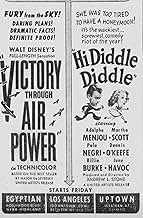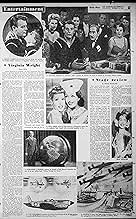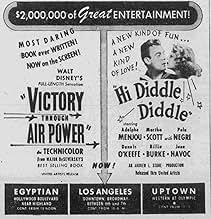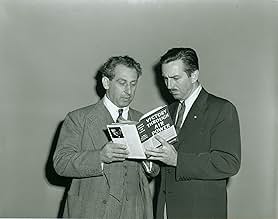IMDb RATING
6.4/10
1.3K
YOUR RATING
An animated documentary promoting of the soundness of strategic aerial bombing in World War II.An animated documentary promoting of the soundness of strategic aerial bombing in World War II.An animated documentary promoting of the soundness of strategic aerial bombing in World War II.
- Nominated for 1 Oscar
- 2 wins & 1 nomination total
Alexander de Seversky
- Self
- (as Major Alexander P. de Seversky)
Art Baker
- Self - Narrator
- (voice)
Billy Mitchell
- Self
- (archive footage)
Featured reviews
I just watched this feature last night from my copy of "Disney Treasures: On the Front Lines," which is an excellent set with many cartoon shorts, educational films, and propaganda films that are unusual of Disney, but nonetheless retain the same feel as the ordinary Disney short.
Being a pacifist, I think that all people should try to understand warfare for what it is, but try to avoid jumping into war until it is absolutely necessary. WWII was indeed a necessary war to fight, and the film, though not specifically aimed to do so, makes this point very clear.
First, before getting directly into the battles, the film educates us on the history of flight. With cartoon humour and sight gags it comes off very entertaining.
Then, the film is turned over to Alexander de Seversky, author of the book on which the film is based. De Seversky makes a valid point that the war should be fought with an enlarged military air force as opposed to naval and land based tactics. He is made to be very informative and enjoyable to watch against the animated maps and diagrams created by Disney's finest animators.
Eerily, there is a link to the 9/11 happening in the idea de Seversky expresses that air power removes the lines between civilians and soldiers and puts the lives of any of us at risk. It is fortunate that he had not lived to see this sad day.
Being a pacifist, I think that all people should try to understand warfare for what it is, but try to avoid jumping into war until it is absolutely necessary. WWII was indeed a necessary war to fight, and the film, though not specifically aimed to do so, makes this point very clear.
First, before getting directly into the battles, the film educates us on the history of flight. With cartoon humour and sight gags it comes off very entertaining.
Then, the film is turned over to Alexander de Seversky, author of the book on which the film is based. De Seversky makes a valid point that the war should be fought with an enlarged military air force as opposed to naval and land based tactics. He is made to be very informative and enjoyable to watch against the animated maps and diagrams created by Disney's finest animators.
Eerily, there is a link to the 9/11 happening in the idea de Seversky expresses that air power removes the lines between civilians and soldiers and puts the lives of any of us at risk. It is fortunate that he had not lived to see this sad day.
Based on the book by Major Alexander de Seversky published in 1941, this film is basically Disney's vehicle for pressing De Seversky's military plan upon Roosevelt, Churchill and the people of America and Britain. De Seversky argued that we should use bombers to attack Axis factories, farms, lines of transportation and resources. Basically, he argued that America and England should begin killing civilians by the tens of millions. And it's a Disney film.
After a brief homage to General Billy Mitchell, the first major animated sequence of the film you've probably seen: "History of Aviation." It starts with the Wright Brothers at Kitty Hawk, and documents the beginning of flight. It then moves on to the formation of the American Air Corps in 1908, early achievements in flight. It shows how aircraft were used in World War I, with the first surveillance planes, the first fighters and the first bombers.
The film moves on to give a history of World War II up to that point, but there are several factual errors, including a sequence where the German Army uses air cover and tanks to break the Maginot Line. In reality, Germany simply invaded France through Belgium. It shows that the invasion of Crete was a great victory for Germany, while it was actually a disaster that nearly failed.
The film then goes on to describe America's role in the war, describing America as the "Arsenal of Democracy." It argues that since American supply lines are thousands and thousands of miles long and German/Japanese supply lines are very short, Japan and Germany have a decided advantage over us. The solution? Stop attacking Hitler's tanks and soldiers, and begin attacking the factories, farms, workers and farmers which build those tanks and feed those soldiers.
The film has a decidedly unsettling tone about it. It begins as a typical Walt Disney cartoon documentary, light-hearted and funny, but it ends describing some of the most disturbing tactics of modern combat, such as blowing up dams to flood the enemy, and employing bombs that will cause earthquakes, perhaps a metaphor for nuclear weapons. It's definitely not for children.
The version found on The Disney Treasures set "On the Front Lines" is only 65 minutes long, and doesn't have the scene that argues that America is the greatest nation for aviators by insulting every nation in Europe, including our allies, France and Britain.
After a brief homage to General Billy Mitchell, the first major animated sequence of the film you've probably seen: "History of Aviation." It starts with the Wright Brothers at Kitty Hawk, and documents the beginning of flight. It then moves on to the formation of the American Air Corps in 1908, early achievements in flight. It shows how aircraft were used in World War I, with the first surveillance planes, the first fighters and the first bombers.
The film moves on to give a history of World War II up to that point, but there are several factual errors, including a sequence where the German Army uses air cover and tanks to break the Maginot Line. In reality, Germany simply invaded France through Belgium. It shows that the invasion of Crete was a great victory for Germany, while it was actually a disaster that nearly failed.
The film then goes on to describe America's role in the war, describing America as the "Arsenal of Democracy." It argues that since American supply lines are thousands and thousands of miles long and German/Japanese supply lines are very short, Japan and Germany have a decided advantage over us. The solution? Stop attacking Hitler's tanks and soldiers, and begin attacking the factories, farms, workers and farmers which build those tanks and feed those soldiers.
The film has a decidedly unsettling tone about it. It begins as a typical Walt Disney cartoon documentary, light-hearted and funny, but it ends describing some of the most disturbing tactics of modern combat, such as blowing up dams to flood the enemy, and employing bombs that will cause earthquakes, perhaps a metaphor for nuclear weapons. It's definitely not for children.
The version found on The Disney Treasures set "On the Front Lines" is only 65 minutes long, and doesn't have the scene that argues that America is the greatest nation for aviators by insulting every nation in Europe, including our allies, France and Britain.
Victory Through Air Power (1943)
*** (out of 4)
With WWII going full strength, everyone in Hollywood did what they could to bring attention and information to the screen and that includes Disney. This animated feature is pretty entertaining in its own right as we learn about the history of aviation and then go into details on how planes are playing a major role in the war.
If you've seen any of the documentaries from this era then you're really not going to learn anything new here. The "Why We Fight" series pretty much covered this stuff in much greater detail but of course the one difference is that this film is animated. The Disney crew really did a terrific job with the animation as it's up to their usual high standards. Fans of Disney will certainly enjoy the animation but WWII buffs will also like the way the documentary shows the bombings at Pearl Harbor and the animated maps on the various issues America faces going up against Japan and Germany.
*** (out of 4)
With WWII going full strength, everyone in Hollywood did what they could to bring attention and information to the screen and that includes Disney. This animated feature is pretty entertaining in its own right as we learn about the history of aviation and then go into details on how planes are playing a major role in the war.
If you've seen any of the documentaries from this era then you're really not going to learn anything new here. The "Why We Fight" series pretty much covered this stuff in much greater detail but of course the one difference is that this film is animated. The Disney crew really did a terrific job with the animation as it's up to their usual high standards. Fans of Disney will certainly enjoy the animation but WWII buffs will also like the way the documentary shows the bombings at Pearl Harbor and the animated maps on the various issues America faces going up against Japan and Germany.
Disney is most known for their family friendly output, featuring lovable characters like Mickey Mouse and Donald Duck. During WWII several of those characters were put in some really unusual situations as Disney were used to output propaganda movies in an attempt to make the public buy more war bonds to finance the war efforts, with Donald Duck in the Oscar-winning Der Führer's Face as the possibly most famous, or even infamous.
Victory Through Air Power is a feature length animated documentary based on the book by Alexander de Seversky, who also features in the movie. It tells the history of aviation, with main focus on the use of airplanes in war situations, and culminates in one man's viewpoint of how the war could have ended. It is the historic parts that really stands out, starting with the Wright brothers and covering the most historic events in early aviation in its recap of aviation history up until WWII started. But the movies message about the importance of an air force in a modern war rings true to this day, and the movie's presentation of how the war could have gone on for many more years than it actually did was also interesting.
There is nothing hasty or cheap looking in this movie, it is a proper, well done feature length animated movie from Disney, and a fascinating ride even today, as long as one has the right mindset for it.
Victory Through Air Power is a feature length animated documentary based on the book by Alexander de Seversky, who also features in the movie. It tells the history of aviation, with main focus on the use of airplanes in war situations, and culminates in one man's viewpoint of how the war could have ended. It is the historic parts that really stands out, starting with the Wright brothers and covering the most historic events in early aviation in its recap of aviation history up until WWII started. But the movies message about the importance of an air force in a modern war rings true to this day, and the movie's presentation of how the war could have gone on for many more years than it actually did was also interesting.
There is nothing hasty or cheap looking in this movie, it is a proper, well done feature length animated movie from Disney, and a fascinating ride even today, as long as one has the right mindset for it.
A history of a propaganda about world war 2 an eagle fighting against an octopus, with more guns and planes this was actually a short that premiered on july 17th from 1943 wait a minute, this was actually a documental, promoting of the soundness of estrategical aerial bombing.
Did you know
- TriviaAfter seeing the movie (at Winston Churchill's urging), Franklin D. Roosevelt finally committed to a full strategic air campaign against Germany.
- GoofsThe film claims the German's used air power to break through the Maginot line to conquer France. In reality, the German forces avoided directly engaging the Line and instead completely circumvented it.
- Quotes
[first lines]
Billy Mitchell: Today, a war is very different than the last European war was. Now air power is the dominant feature of military operations. Air power can fly directly to the vital centers of an opposing state and neutralize them. It can destroy the cities, it can wreck the aqueducts, it can knock out the lines of communication, it can destroy the food supplies, and make the people helpless to resist.
- ConnectionsEdited into La castagne (1945)
- How long is Victory Through Air Power?Powered by Alexa
Details
- Release date
- Country of origin
- Language
- Also known as
- Victory Through Air Power
- Filming locations
- Production company
- See more company credits at IMDbPro
Box office
- Budget
- $788,000 (estimated)
- Runtime
- 1h 10m(70 min)
- Color
- Aspect ratio
- 1.37 : 1
Contribute to this page
Suggest an edit or add missing content






















